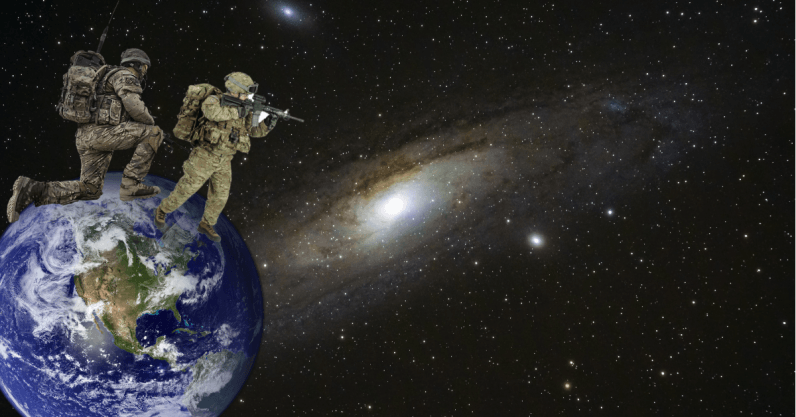
It is quite easy to understand how scientists from select fields can be enlisted for the war effort. For example, the biologist and the chemist are experts in chemical warfare, the physicist in making of bombs and movement of energy, as engineers turn words into action. But the role of astronomers in matters of conflict is, to say the least, not well understood.
A case can certainly be made where one can trace the importance of celestial navigation to the movement of armies and fleets. Nonetheless, other connections are hard to find. In present times, the small community of astrophysicists is overwhelmingly liberal and anti-war. So how much weight does a book about the unspoken alliance between astrophysics and the military hold?
Tribune Take: Reading habits of Pakistanis on print and digital
The answer to the question is a resounding 'it carries weight alright'. In a new book which aims to explore the history of astronomy and military strategy, astrophysicist Neil deGrasse Tyson and art historian Avis Lang take us on a journey over hundreds of years, peeking into the past, present and future of war planning and space studies, and the business partnership between the two.
The work has received positive reviews from many publications, with NPR calling it a wake-up call for pacifists, The Space Review saying the book has come at the best and worst of times for space, The Washington Post classifying it as a work of ample research and nimble story-telling, and NYT terming it a clearly organised book by scientific-minded authors with a literary flair.
Neil deGrasse Tyson works at American Museum of Natural History and is a famous astrophysicist, starring as host in popular television series Cosmos. He has also written a few books on science, including the best-selling Astrophysics for People in a Hurry.
The incredible story of the man who raised Malala
Avis Lang is a research associate at Hayden Planetarium, American Museum of Natural History. Apart from being a researcher and a celebrated author, she has been editing the works of Tyson for two decades, including his monthly column for Natural History magazine.
Lang has a masters degree in art history and an undergraduate degree in English. Her passion for writing about science and space is unlimited, and apart from editing books, she has been writing about space and space policy for reputable publications over the years.
More recently, Tyson was embroiled in a months-long investigation into allegations of sexual misconduct leveled against him by several women as part of the global movement against harassment. Media outlets are now reporting that the results of an internal inquiry by a private broadcast network into the matter has cleared the academic of any wrongdoing, and he is slated for a return to television soon.
Absurdities of contemporary warfare collide as satirical thriller bites literati
Accessory to War: The Unspoken Alliance between Astrophysics and the Military was published by WW Norton and Company on September 11, 2018. An audio book of the publication, narrated by Courtney Vance, also accompanied the release. The narration earned Vance a Grammy Award nomination in the Best Spoken Word Album category.
Spanning millenniums, the work examines the role astronomers have played in military planning, from navigating the stars to making satellite weapons. In addition, the volume looks at how science, industry, technology and politics influence each other.
The Express Tribune spoke to authors Avis Lang and Neil deGrasse Tyson on their new book, astrophysics and the importance of policy-making in science. Parts of the conversation with the celebrated academics have been reproduced below for interested readers. A short review of Accessory to War follows this interview.
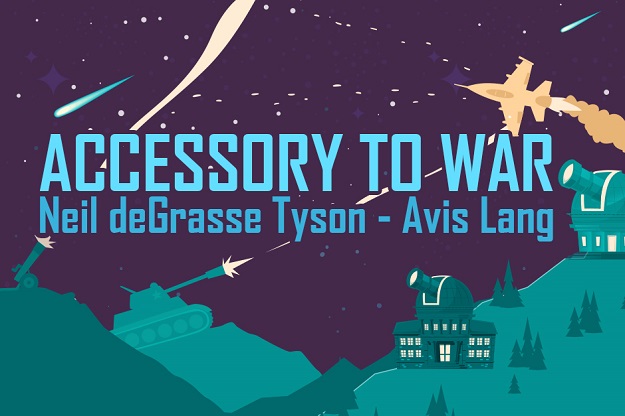 CREATIVE: IBRAHIM YAHYA
CREATIVE: IBRAHIM YAHYAIn conversation with Avis Lang and Neil deGrasse Tyson
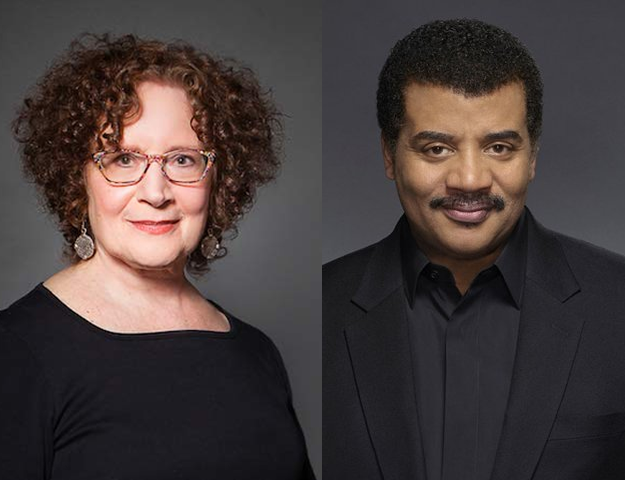 Hayden Associate Avis Lang (left) and astrophysicist Neil deGrasse Tyson (right).
Hayden Associate Avis Lang (left) and astrophysicist Neil deGrasse Tyson (right).What are some of the ways in which policy makers can safeguard that peaceful astrophysical research will not be used for the creation of weapons?
AL: The dedication of our book reads, "To everybody who has ever wondered why astrophysicists have jobs at all." Although seemingly lighthearted, this dedication addresses the core of the age-old, two-way-street alliance between astronomy/astrophysics and warmaking.
In the modern world, scientific research is often funded by the state, and the state's policymakers are less interested in basic research than in preserving and aggrandizing the state and its hierarchies. The policymakers' job is, in effect, to uphold the concentration and distribution of power.
In addition, there may be a fundamental clash in thinking -- a profound tension -- inherent in the linkage you present between policymakers and researchers. Scientists whose work might be called "pure" or "basic" and who intend it as peaceful are in pursuit of a very long-term goal: the acquisition of knowledge.
Policymakers operate in the political realm -- the short-term realm of expediency, compromise, limited goals intended to bolster or consolidate money's liaison with power, quasi-solutions that fundamentally solve very little.
Furthermore, basic research into the attributes and dynamics of the universe, once it has proven accurate, becomes useful for those who have goals other than knowledge. Who can best understand the ramifications of rarefied astrophysical research? Who can best delineate safeguards?
The scientists themselves. They are the ones who can best understand how their peaceful research can or might be applied to non-peaceful ends. Yet dedicated scientists are generally committed to taking their research as far as it will go. They want no limits placed on their pursuit.
Perhaps only when the most fundamental mechanisms that animate social organization and preserve ordinary human life on Earth are threatened will scientists -- and technologists -- focus on the larger context and bring themselves to say, "This far and no farther."
We've recently seen indications of this in another domain: employees of Google and Microsoft refusing to pursue certain lines of R&D. Knowledge, once gained, is always susceptible to unexpected, unimagined, or even unthinkable applications.
It may often be futile to expect that policymakers take the lead in protecting the best interests of humanity. In our context, scientists are better placed to do so.
NT: The astrophysicist does not make missiles or bombs. Instead, we and the military care about the same things: multi-spectral detection, ranging, tracking and nuclear fusion.
The overlap between the two is strong and the knowledge flows in both directions. The book explores this relationship since the earliest times, and my time advising the US government has led me to imagine what such encounters between rulers and scientists might have been like over the centuries.
Your co-author has penned a wonderful tribute to you in the introduction of the book. Can you elaborate on the process which goes behind collaborating on a book with a scientist?
AL: Every scientist is different: different work habits, different personalities, different quirks. Hence I cannot speak of working with "a" scientist. These people are hardly generic!
Over our two decades of working together, Dr. Tyson and I gradually came to recognize and understand each other's strengths, limitations, beliefs, and preferences, and once we started working on this book, it was basically up to me to figure out how to dive into the specifics of the subject matter and how to keep up the momentum.
One excellent aspect of writing with him is that we both care very, very much about making every sentence as good as we can make it, and we often exchange many, many emails about a single word or paragraph. We each argue our point of view, we suggest multiple alternatives, we consider each other's statements carefully.
In the end, fortunately, Neil is a rational person and can be convinced to change his thinking. And in addition, if we run out of rational arguments, we both occasionally "permit" the other person's preferred wording to remain.
Also, people who are writing something together must always be prepared to explain exactly WHY they don't like a particular phrase or WHY it can be misinterpreted. You cannot just say, "This sounds horrible."
You must always politely explain the problem and suggest alternatives, and both of us are almost always willing to stick with a problematic passage until we arrive at something we both like or can at least tolerate.
NT: Co-author Avis Lang is a consummate researcher and an avid writer and this book is a fusion of our talents.
Our writing and editing compensates for the weaknesses of the other person, and the book got done because of the long-term commitment of Avis to examining the role of science in society.
The book is dense and well-researched, and reads like a commentary on governmental space policy over the years. Do you think the US has lost its status as the space superpower in the face of Chinese ambitions over the past few years?
AL: There is no shortage of US documents, reports, position papers, public hearings, op-eds, etc., that lament the metamorphosis of China into a formidably ambitious, high-achieving space power in recent years.
Should the world be comfortable with a single space superpower, or would it be better off -- i.e., would the planet and its inhabitants be safer -- with multiple space powers, ideally collaborating with one another on colossal endeavours that simply are too vast for a single nation, even the world's most populous nation, to pursue on its own?
Astrophysics is a far-cry from art history. Can you tell us a little bit about your journey from art and history to science and literature?
AL: Art history in my era as a graduate student had not too much to do with history, and my undergrad degree was in English, so my journey was really from art to the history of science. I like to think of Accessory to War as equal parts history and science.
In any case, my career in art history/art writing/curating took place mostly in Canada. I moved to New York in 1983, became the kind of editor who deals with improving the language & clarity of writing on a wide range of topics, and eventually wound up at Natural History magazine, a publication originally one of the activities of the American Museum of Natural History.
The Hayden Planetarium, of which Dr. Tyson is the director, is physically and organizationally part of the museum, and Dr. Tyson wrote a column for the magazine for more than a decade ("Universe").
So, all these strands came together for me in 2002, when the ownership of the magazine changed hands and I became Dr. Tyson's editor. Before working at Natural History magazine, the phrase "cosmic microwave background" had never entered my field of vision, and suddenly I had to plunge into polishing and fact-checking (!) essays about dark matter, dark energy, the Big Bang, and new methods of spacecraft propulsion.
To my mind, the key was my "liberal arts education," a somewhat old-fashioned term. It was the sort of broad education that my own friends from South Asia apparently had, that so many brilliant contemporary South Asian scientists and novelists clearly had, an education through which one learns to read and re-read and re-re-read difficult materials on a wide range of subjects.
You read and ponder and then read more until you grasp a new or alien concept. Ideally you become what could simply be called educated.
In the end, the combination of my commitment (and obligation, since it was fundamental to my job) to comprehending new things with Dr. Tyson's talent for communicating science to ordinary people turned out to be extremely workable.
It wasn't easy for me to make that journey from art to science, but it was totally, completely worth the effort!
Would you care to comment on the harassment allegations against your co-author?
AL: Among my co-author's attributes that are obvious to anyone who has heard him interviewed or watched him on TV is that he is friendly, lively, warm, enthusiastic, and playful. What they probably wouldn't have had the opportunity to see is that he is also generous, loyal, and fair-minded. Never have I experienced or witnessed him do anything that could be called harassment.
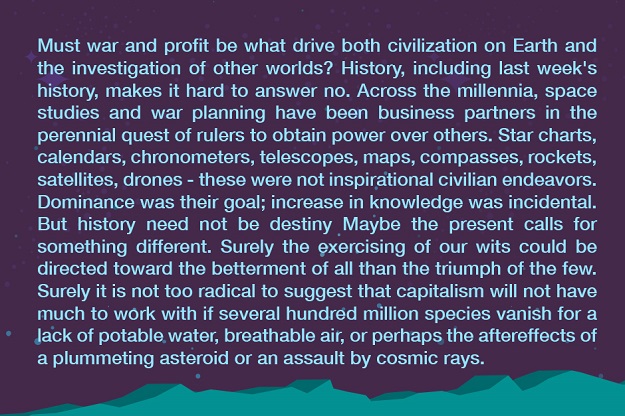 CREATIVE: IBRAHIM YAHYA
CREATIVE: IBRAHIM YAHYAAccessory to war
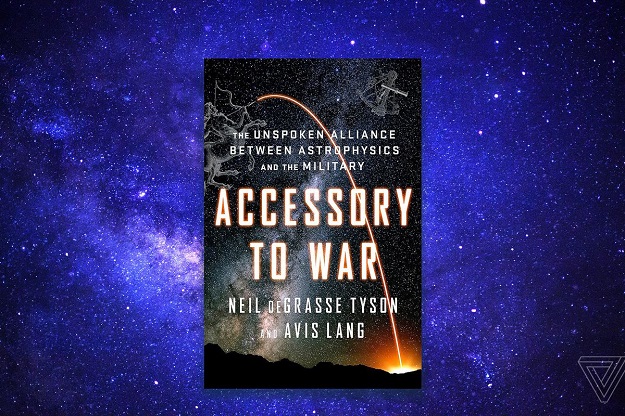 PHOTO COURTESY: THE VERGE
PHOTO COURTESY: THE VERGEThe authors have divided the book into two parts, one laying the groundwork for the reader to understand space policy and history, and the other to exploring the relationship between astrophysics and war, from information operations to the making of weapons.
The book begins with Tyson narrating his experiences at a National Space Symposium in 2003, wherein the US military and space community came together to celebrate science and the dropping of bombs on the people of Iraq. Although Tyson says he is a liberal, he says he is not so far left of the political spectrum as to lose sight of some of the more nuanced arguments coming from the conservative side.
Case in point: Tyson was not very happy with the anti-war protestors swarming outside the venue of the space conference, but equally appalled by the actions of some of the attendees at the symposium, who cheered and applauded as live streams inside broadcast the bombardment of Iraq by US forces back in 2003. This book can perhaps be read as an attempt by Tyson to reconcile the two conflicting emotions he felt that day.
Rekindling the light snuffed out by patriarchal honour
Apart from talking about astronomy, the book delves into astrology, navigation, astrophysics, history and strategic studies. One especially distinctive feature of the work is the retelling of the events of the Cold War and how they influenced space policy, and ultimately investment in science, during the latter half of the twentieth century.
According to the authors, United States has made some questionable decisions with regards to space technology in recent years that will hurt the status of the North American nation as a space superpower if drastic measures are not introduced to tackle them. Chinese ambitions and rising global clout is just one of the threats that could challenge American hegemony above ground, warn Tyson and Lang.
Interestingly, Accessory to War also lists the collective efforts of the scientific community against the offensive use of space technology. For example, the Strategic Defense Initiative launched by former US President Reagan, and brought to reality by scientists, sought a system that would render the doctrine of mutually assured destruction obsolete by developing technology to counter ballistic nuclear warheads. In addition, scientists also played a vital role in the signing of the space treaties that effectively declare the realm the shared heritage of humankind.
Orient meets Occident as Louvre Abu Dhabi rains light on art
The book is well-researched and meticulously edited, containing almost one-hundred and fifty pages of notes and selected sources that the authors used in producing this volume. Tyson and Lang have made it a point to carefully and clearly explain complex scientific phenomenon, linking them to everyday occurrences.
Politics, science and the military come together to present a tale rich in irony. To quote one example from the work of Tyson and Lang, the story of Hans Lipperhey is re-told, a spectacle-maker from the seventeenth century who inadvertently influenced the signing of a truce that brought eighty years of war in Europe to and end by introducing a royal court to a new type of telescope.
The 'colonisation' of space gets ample coverage as well. The proliferation of satellite technology, and the deployment of manned missions to space in the past few decades have brought complex questions regarding the human quest to master the 'final frontier' into the fore, and the research explores these at length. The tussle between state and scientist is likely to intensify, and the book is clear, focused and sprawling in scope to spell out present scholarship on the issue.



1730959638-0/trump-(19)1730959638-0-165x106.webp)













COMMENTS
Comments are moderated and generally will be posted if they are on-topic and not abusive.
For more information, please see our Comments FAQ